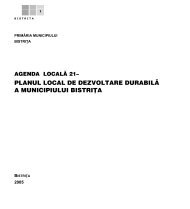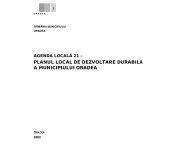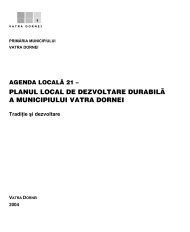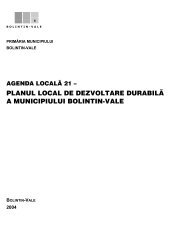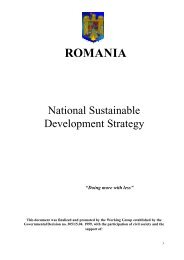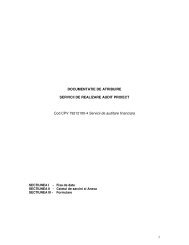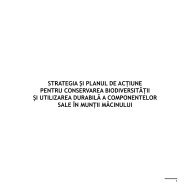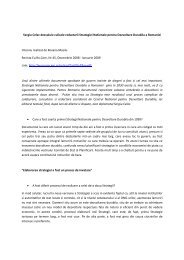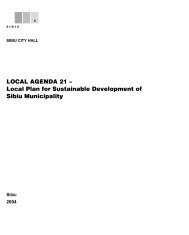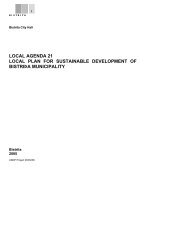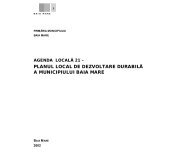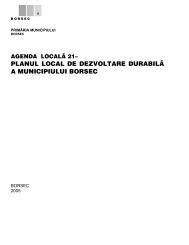LOCAL AGENDA 21 â LOCAL PLAN FOR SUSTAINABLE ...
LOCAL AGENDA 21 â LOCAL PLAN FOR SUSTAINABLE ...
LOCAL AGENDA 21 â LOCAL PLAN FOR SUSTAINABLE ...
You also want an ePaper? Increase the reach of your titles
YUMPU automatically turns print PDFs into web optimized ePapers that Google loves.
43GIURGIUII. OBJECTIVES, SCENARIOS ANDPOLICIESII.1. CONTEXTObjectives pertaining to sustainable development inGiurgiu take into account the two stages ofurbanisation that occurred over the last 50 years. Thefirst stage, from the 1950s to the 1980s, wascharacterised by an accelerated expansion of the realestate, following on the development of the goodsprocessing industry. Rapid urbanisation negativelyimpacted the urban design, habitat, local culture andenvironment, and subsequently led to a process of deurbanisation.The second stage began in 1990 andcarried on previous problems that aggravated overtime. Moreover, slow economic restructuring led tozero population growth.Similar urbanisation patterns could be observed inother urban settings in Central and Eastern Europeand in several peripheral EU countries (the so-called“cohesion” countries: Spain, Portugal and Greece).Noticeably, urbanisation was slower in Europeancountries with a peripheral, unstructured economy,and more rapid in areas with a strong economy,particularly in the tertiary sector of research andeducation. Rapid and profound structural changesfostered the formation of three well-developed,regenerating types of urban settings: i) old core inBelgium, the United Kingdom, north-eastern France,Luxembourg, Holland, northern Germany andDenmark; ii) new core in southern Germany, northernItaly, south-eastern France, central and eastern Spain;iii) periphery in the rest of Spain, Greece, southernItaly, Portugal, western France and Ireland 1 .Generally speaking, development or regeneration ofan urban settlement is significantly correlated withchanges in the structure of the economy, populationand local culture. Along the same lines, developmentof an urban setting is to a great extent influenced byadequate management practices focusing on fourmain targets: infrastructure development and provisionof public access to this infrastructure; affordablehousing; environmental protection; and fightingpoverty. At the same time, urbanisation must take intoaccount the limited availability of resources (human,natural and financial), and that this might preventauthorities from managing all the problems of acommunity. Urban development must also correlatethe careful distribution of resources and avoid the”crowding out” effect (increased public expenditurescause a decrease in private investment). Publicauthorities must constantly evaluate investmentopportunities, not only in relation to the availability ofcurrent and future financial resources, but also as afunction of the community agenda. Authorities shouldfoster a sense of responsibility in individuals and thecommunity, and promote partnerships in projects forlocal development.Last but not least, urban development is correlatedwith the redefinition of urban design. Urban culturaltraditions and social equilibrium have been profoundlyaffected by the architectural approach to civilengineering from 1950s to 1980s and by the kitschconstructions of the 1990s. Urban landscaping mustbe completely redefined, so as to incorporatearchitectural features specific to the respective regionor architectural styles of Western influence.1European Sustainable Cities: European Urban Systems:Chapter 2, sec.4. Expert Group on the Urban Environment,European Commission, Directorate General XI, Environment,Nuclear Safety and Civil Protection, Brussels, March, 1996.



